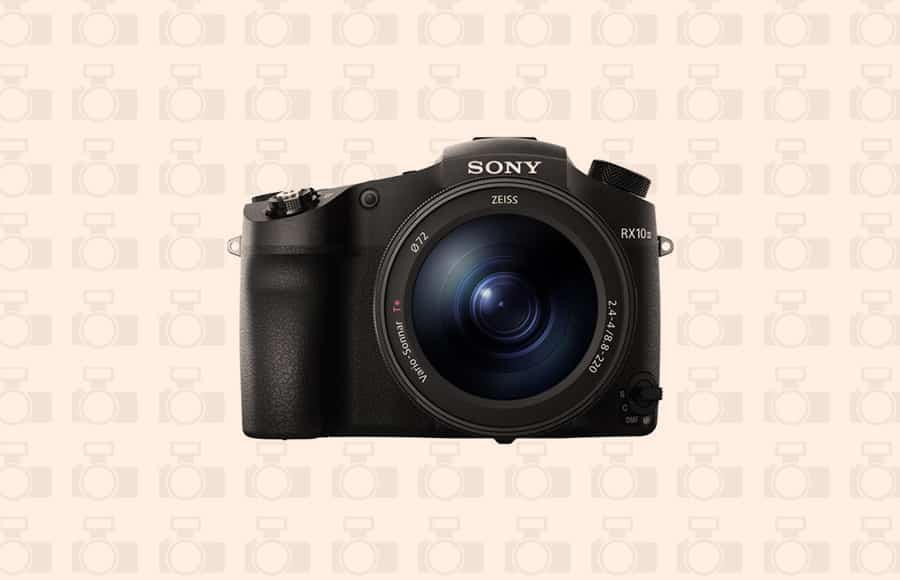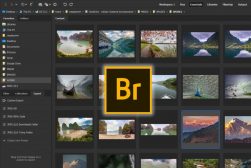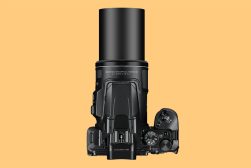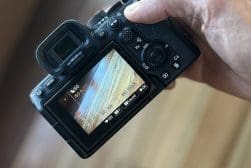
Best Bridge Camera for Simplified Photography
The performance of a DSLR meets the portability of a point-and-shoot… Win-win! Check out this guide to find the best bridge camera for you.
If you’re in the market for a camera that offers the performance of a DSLR and the form factor of a point and shoot, a bridge camera is for you.
Be it for holidays, family portraits or weddings, these nifty little cameras come in handy without much compromise on image quality and shooting experience.
Good photography is all about taking control of the exposure. With the best bridge cameras, you can adjust a variety of settings including aperture, shutter speed, and ISO.
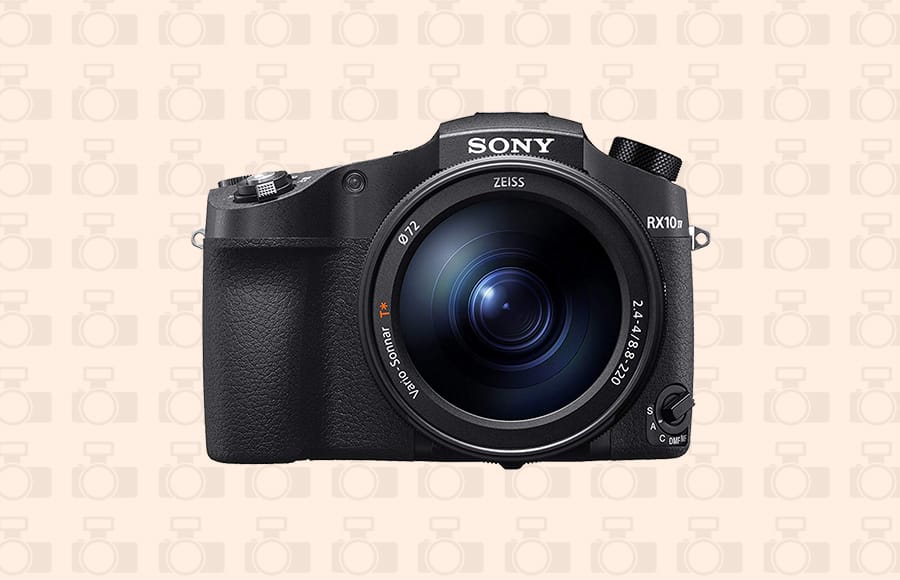
Fast, sharp and with impressive zoom capabilities, this is one camera that can do it all.
Quality images, advanced DSLR-like features, and versatility sets these cameras apart from smartphones and digital point-and-shoots.
If you’re tired of carrying multiple heavy lenses ranging from a wide-angle to telephoto, a bridge camera can lighten up your bag considerably. Be it sweeping landscapes or candid portraits, it can do it all.
If you’re not sure which one to buy, don’t worry: we’ve tested multiple options and come up with the best five bridge cameras you can buy in 2024.
Top Bridge Cameras in 2024
| Image | Product | Features | |
|---|---|---|---|
 | Sony RX10 IVOUR #1 CHOICE |
| View Price → |
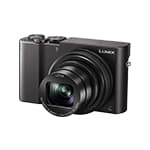 | Panasonic Lumix ZS100LIGHTEST |
| View Price → |
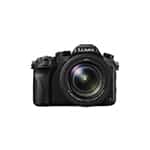 | Panasonic Lumix FZ2500BEST FOR PROS |
| View Price → |
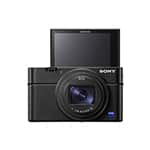 | Sony RX100 VIIGREAT VALUE |
| View Price → |
 | Sony RX10 IIIBEST FOR BEGINNERS |
| View Price → |
1. Sony Cyber-Shot RX10 IV
- Super-sturdy build
- 3-inch tilting touch screen
- 24 fps shooting
- SteadyShot Optical Image Stabilization
- Bluetooth, NFC and Wi-Fi connectivity
- Touchscreen can’t be used to navigate function menu
- Slightly bulky
The early bridge cameras were developed around point-and-shoot technology with added manual controls. While they provided a DSLR-like experience with fixed zoom lenses, the image quality wasn’t much of an improvement.
That was the case until Sony released its RX10 bridge camera series. The RX10 featured a larger 1-inch sensor and a robust weather-sealed body that was seen only in professional DSLRs. (See our article on the types of camera sensor to learn more about why the size here is important.)
The fourth generation of the series, the RX10 IV is the latest bridge camera from Sony.
The design of the RX10 IV looks similar to the previous generation; however, it packs a lot of new features.
The body is shaped similar to a DSLR, but the lens is a fixed 25x zoom. There’s no need to change lenses whether you’re shooting vast landscapes or zeroing in on the supermoon.
Like the older generations of bridge cameras, the RX10 IV has a fully weather-sealed body that can withstand light rain, snow, and dusty environments.
One of the areas where the RX10 IV shines is the build quality: it’s built around a magnesium alloy chassis that makes it sturdy. The exteriors are made with metal, but a bit of rubber and polycarbonate is used for better ergonomics.
The body weighs 2.4 lbs (1.08 kg), which is lightweight for the impressive zoom range it covers – see the best super zoom cameras.
The RX10 IV supports fast UHS 1 memory cards up to 64 GB. However, if you prefer to not spend too much on storage, the standard speed SD cards are also supported.
The sensor on the RX10 IV is Sony’s 20.1 MP Exmor RS, a 1-inch stacked sensor that produces high-quality images.
It comes with an ultra-sharp Zeiss Vario-Sonnar T lens that covers the focal range of 24mm to 600mm in 35mm equivalence.
Despite covering an extended zoom range, there’s no compromise on image quality. The lens on the RX10 IV produces a significant level of detail, sharpness, and vivid color throughout.
On the wide end, the maximum aperture is a large f/2.4; however, it reduces to an f/4 on the tele end. The f/4 aperture at 600 mm is a great deal considering it is found on some of the expensive super-telephoto lenses.
When shooting at low shutter speeds, even the slightest movement can introduce blur in your images. However, with the RX100 IV, the SteadyShot optical image stabilization enables you to retain sharpness by stabilizing up to 4.5 stops.
If shooting sports or fast-moving subjects is your thing, the RX10 IV is the best bridge camera for you. You can shoot images at a fast speed of 24 frames per second, with auto-focus on. On top of that, it can lock focus on a subject in just 0.03 seconds.
The RX10 IV has the upgraded Bionz X image processor, which is also found in Sony’s flagship full-frame camera, the Alpha a9. Combined with the stacked EXMOR RS sensor, this image processor gives the performance a significant boost.
The ISO range of 100-12,800 (expandable to 64-25,600) makes it possible to shoot in very low-light conditions.
The video capabilities of the RX10 IV have been upgraded considerably from the previous generation. It features support for shooting 4K videos at a maximum of 30fps.
At 1080p, it can shoot videos at a maximum of 120fps. It also supports the Sony log formats, which provide great flexibility during editing and color-grading.
The extreme focal length coverage and the pro-grade video features make the RX10 IV one of the best travel video cameras on the market.
It offers a mechanical shutter that can shoot at a max speed of 1/2000, and a silent electronic shutter that can shoot at a maximum of 1/32000 of a second. With Sony’s implementation of anti-distortion technology, the rolling shutter effect is significantly reduced.
The 2.35-million-dot electronic viewfinder is the same used in the previous generation. However, with the new image processor, display lag has been eliminated.
It features a 3-inch tilt touch screen display on the rear that supports focus by touch. The resolution has been slightly upgraded from the predecessor to 1.44 million dots.
Thanks to plenty of connectivity options – from Bluetooth to NFC and Wi-Fi – your pictures are easily accessible on a smartphone, PC, or other devices.
With these impressive specs and the ability to achieve great results, the RX10 IV is our number one pick for the best bridge camera 2024 has to offer.
2. Panasonic Lumix DMC-ZS100
- Compact and lightweight
- Viewfinder included
- Good in low light
- RAW file support
- Fixed LCD
- Some edge softness at the wide end
The ZS100 is a lightweight bridge camera from Panasonic. It’s a step ahead of the previous generation of bridge cameras in terms of features and performance.
Starting with the physical appearance of the camera, it has a slim body that can fit in any handbag or a big pocket when turned off. However, the lens protrudes when you turn the camera on.
While many 1-inch digital bridge cameras in this range have opted for screen-only shooting, it’s a relief to see a viewfinder on the ZS100.
Another good thing is that this option on the best bridge camera list weighs only 0.68 pounds (311 grams), and is a joy for long duration shoots.
There are plenty of physical buttons on the camera, which lets you adjust critical settings without digging deep in the menu.
The 20.1 Megapixel 1-inch sensor on the Panasonic ZS100 is a welcome addition compared to the 1/2.3-inch sized sensor that the previous generation in the series used. The relatively bigger sensor has considerably improved images and low light performance.
The cherry on the cake is the support for RAW files, which gives you a lot of flexibility in post-processing. The RAW + JPEG shooting option provides the best of both worlds: easy shareability and intensive processing.
The camera has a full manual mode where you can control aperture, shutter, and ISO as per your liking as well as the Program, Aperture, and Shutter priority modes.
The JPEGs out of the Panasonic ZS100 look impressive and are rendered with beautiful colors. The built-in noise reduction cleans images without losing out on the details.
Unlike the RX10 IV detailed above, it doesn’t have a hot-shoe connector for external flash. However, it comes with a pop-up flash which has excellent illumination and range for its size.
The 1160k-dot electronic viewfinder on the Panasonic ZS100 is sharp and has vibrant colors. Just note that the magnification is limited to 0.46x.
The 1040k-dot 3-inch display is sharp, and touch support makes it very quick to set up the camera.
The maximum ISO is 12800. Given the size of the sensor, high-ISO images do produce a little grain. However, if you choose to shoot JPEGs, the internal noise reduction results in clean images.
The RAW files offer a high dynamic range in low light situations.
The 10x Leica DC VARIO-ELMAR lens on the ZS100 provides a focal range of 25mm to 250mm (35mm equivalent). The extended focal range beats other cameras in this price range.
The max aperture is a large f/2.8 at 25mm, and it closes down to an f/5.8 when it reaches 250mm.
RAW files and 4k videos are usually massive files that require ample storage. Thankfully, with the ZS100 you can use memory cards of up to 128 GB in SDHC and high-speed SDXC formats.
The hybrid Optical Image Stabilization on the ZS100 uses 5-axis to correct blurring in the handheld photos. The photos shot with OIS on are sharp and usable even at shutter speeds as low as 1/10. The AF system provides 49 AF points and can also detect and track eye and face.
Also, the shutter speed with the mechanical shutter can be set from 60 seconds to 1/2000 second and from 1 second to 1/16000 second when using the electronic shutter.
As per the CIPA rating, the battery on the ZS100 lasts 260 shots when EVF is used and 300 when the rear display is used. The camera charges via a USB port; no external charger is provided.
With Panasonic pushing 4K shooting in all its cameras, the ZS100 gets ultra-HD support. The videos can be recorded at 4K resolution with 24 or 30 frames. However, if you use 1080p, it can go up to 60 frames.
Photos get the 4K boost as well as video with this camera, which enables you to save 8.3 MP photos from your 4K videos. Note though that this feature is available only with videos shot at 4k.
The ZS100 also provides Panasonic’s Post Focus functionality, which lets you choose the pictures to keep as per the focus.
The ports on the camera are limited to a micro-USB and a micro-HDMI. However, there is in-built Wi-Fi, which enables you to transfer images directly to your iOS and Android smartphones via the free Panasonic Image app.
You can also use your phone as a remote to shoot with your camera: you can zoom, adjust settings, and use the phone screen for touch focus.
The high-end features of the ZS100 and the extended zoom range make it a perfect choice for most shooting scenarios and the best bridge camera in its price range.
3. Panasonic Lumix DMC-FZ2500
- Sturdy build
- 4k video
- Fast autofocus
- Highly customizable
- No weather sealing
- Some inconsistent lens performance
The Lumix FZ2500 is a well-made superzoom camera by Panasonic. The impressive feature list includes ultra-high-resolution video and stills capabilities and many advanced DSLR-like features. Overall, it leaves nothing left to be desired when it comes to bridge cameras.
In terms of appearance, this camera closely resembles a DSLR. The main difference is the sensor size and lack of lens interchangeability.
The body is made with polycarbonate with the use of metal and rubber in some places. Unlike the RX10 IV, it doesn’t come with weather sealing – but light rain or a few drops of water won’t necessarily harm it.
The build is sturdy, and the camera feels solid in your hands.
It covers the focal range of 25mm to 480mm (35mm equivalent), which isn’t as long as 25 to 600mm on the RX10 IV. However, it weighs slightly less at 996 grams.
Another impressive thing is the number of customizable buttons on the camera – the functions buttons are even present on the lens.
Despite the long lens on it, the Panasonic FZ2500 gets ready to shoot very quickly in only 1.3 seconds.
The 20.1 MP 1-inch sensor comes with backside illumination, which makes it more sensitive in low-light situations. The images are sharp and vibrant and pack a significant amount of details.
This camera also supports RAW capture, which gives you ample post-processing flexibility.
On burst shooting mode with a single point of focus, it can capture RAW images at 10 fps and JPEGs at 11 fps. With continuous focus, the frame rate drops to 7 fps.
The images out of the FZ2500 are tack sharp with accurate color reproduction.
The overall performance is impressive throughout the extended zoom range, and to call it the best bridge camera for professional shooters isn’t a stretch at all.
It also provides a hotshoe mount for external flash and also an in-built flash. The inbuilt flash is useful for backlighting scenarios and indoors.
The ISO range is 80-25600. The pictures are mostly grain-free until ISO 3200; from ISO 640, the grain becomes noticeable in the image. That said, the overall low-light performance is pretty reliable.
The EVF is one of the best of any bridge cameras. It’s based on an OLED display that offers 2.36 million dots, is sharp and provides 0.74x magnification. The colors are vivid, and it maintains a good contrast even when shooting in low-light conditions.
The rear LCD is a 1040k-dot 3-inch tilt and swivel display that can rotate to face the user. It also features touch functions, including focus, pinch-zoom, and other settings.
The Leica Vario-Elmart f/2.8-4.5 20X optical zoom lens that comes with the FZ2500 is a versatile optic. The max aperture on the wide end is f/2.8 and f/4.5 when zoomed out.
It produces maximum sharpness in the middle of the image which diminishes a bit on the corners. Chromatic Aberrations are minimal even on the tele end of the lens.
The FZ2500 also features a built-in ND filter that can cut exposure in variations of 1/4, 1/16, 1/64.
It supports SD card of UHS speed class 3 of up to 128 GBs. Though it supports lower speed cards, the high-speed storage is recommended for 4K video recordings.
The focus stacking feature is an excellent tool for macro photography and also allows you to choose the focus after the capture.
The battery life on the Panasonic FZ2500 is rated for 270 shots with EVF and 350 shots with LCD by CIPA.
The mechanical shutter goes as fast as 1/4000 and electronic shutter at 1/16000.
The sensor allows shooting in 4K Ultra HD (3840×2160) as well as 4K DCI (4096×2160) videos. You have the option to shoot videos at 24fps or 30fps in 4K; however, with 1080p, you can go as high as 60 frames.
The FZ2500 comes with a microphone jack for high-quality audio. It also features in-camera cinema-style color gradation with CINELIKE D and CINELIKE V features.
Additionally, this camera offers live HDMI out to an external recorder with 4:2:2 in 8-bit or 10-bit with a 100 or 200 MBPS bitrate. Also, you get the creative flexibility with support for ND filter in video mode.
This bridge camera comes with plenty of ports: shutter release port, micro USB, Micro HDMI, and a 3.5mm jack for headphones and mic. The battery can only be charged externally with the supplied charger.
If you’re keen to transfer your photos to your smartphone quickly and easily, you can do so using the inbuilt Wi-Fi. As an added bonus, you can download the Panasonic Image app, which enables you to use your phone to operate the camera.
Is the Panasonic FZ2500 the very best bridge camera out there? That depends a little on your requirements – but with excellent features and impressive image quality, it’s definitely high on the list.
4. Sony RX100 VII
- Easy to use
- Light and pocketable
- Excellent sharpness
- 20 fps with subject tracking
- No rubber grip
- A little pricey
The RX100 VII is the latest offering from Sony – a feature-rich compact camera that packs a lot of punch for its small size.
The body of the RX100 VII Sony bridge camera isn’t the smallest we’ve seen during this search for the best bridge camera, but it’s compact enough to fit in your jacket pocket. It also weighs a slight 0.66 pounds (303 grams), which makes it very easy to carry with you at all times.
When you turn the camera on, the lens protrudes out and zooming in does make it a bit longer. The construction is mostly metal with the use of a reasonable amount of plastic.
How about ergonomics? Well, there’s no rubber grip, but considering the small weight of the camera, that’s hardly a big deal.
The sensor on the Sony RX100 VII is a 20.1 MP 1-inch EXMOR RS, the same we’ve seen in the much more expensive RX10 IV. It produces excellent picture quality with vivid colors and details.
The images are very sharp throughout the zoom range of the 24mm to 200mm (35mm equivalent) zoom lens.
It features full manual controls as well as aperture, shutter priority, and program modes. The auto and scenes modes are also available if you prefer a point-and-shoot style shooting.
The new BIONZ X image processor, coupled with Sony’s stacked sensor, works well to provide the camera its outstanding focusing capabilities. The AF system features a total of 425 contrast-detect AF points and 357 phase-detection AF points.
The focus is snappy, even in low-light conditions. Another plus is that the RX100 VII supports Sony’s newly developed real-time Eye-AF and tracking.
It also comes with an in-built flash; however, there’s no hot-shoe mount to add external flash as we’ve seen in the RX10 series.
The ISO range is 100 to 12800 and is expandable to ISO 64 on the lower side. The high-ISO images are mostly grain-free until ISO 6400.
The viewfinder on the RX100 VII is not visible on the outside – it’s revealed with a pop-up mechanism. It’s built around an OLED display and provides a 0.59X Magnification.
The rear display, meanwhile, is a sharp 921k-dot tilting LCD with touch support. You can tilt the screen up and down as well make it face front for vlogs.
The RX100 VII supports high-speed UHS 1 memory cards and is also compatible with SD and SDHC cards.
When shooting with a single locked focus point, you can get continuous shooting at 30, 60 or a mind-blowing 90 fps. Even with full auto-focus and auto-exposure on, the speed stays at an impressive 20fps with the electronic shutter.
When it comes to video, the stabilization is one of the most sought-after features. With the Sony RX100 VII, you get electronic stabilization as opposed to the OIS we saw in the RX10 series. You might notice a minor crop of the frame while shooting stabilized videos.
In terms of video resolution, the camera offers 4K video recording with an option to shoot at 30p or 24p. It also offers a 4K HDR option. If you want to shoot at a lower FHD resolution, the frame rate can be raised to a maximum of 120p. You can record impressive 960p super slow-motion videos.
On a full charge, the battery provides 240 frames with EVF and 260 if you use the LCD. It’s not a high number of photos, but for this small-sized camera, it is decent.
Also, USB charging is available for conveniently charging on the go.
For the ports, it has micro-USB and a 3.5mm Microphone Jack. The wireless connectivity options are Wi-Fi, Bluetooth, and NFC.
For smartphone connectivity, the RX100 VII supports Sony’s Play Memories smartphone app.
All in all, this tiny package offers a lot to be desired. If you’re after something portable but powerful, this is the best bridge camera for you.
5. Sony Cyber-shot RX10 III
- Super fast autofocus
- Dust and splash resistant
- 960-1000 fps slow motion
- Excellent optics
- Heavy
- No touch controls
The release of the RX10 IV had brought many enhancements; however, the RX10 III is still a strong contender among the best bridge cameras on the market.
This camera is made for serious photographers who seek an all-in-one camera with excellent image quality.
It’s designed to look like a DSLR; however, like other bridge cameras, this too has a fixed zoom lens. It offers an extended zoom range of 24mm to 600mm, which is 400mm longer than the RX10 II.
The camera weighs a massive 2.4 pounds (1.08 Kilograms), which is a lot heavier than the entry-level DSLRs. However, much of the weight is because of the excellent quality zoom lens that covers a wide range of focal lengths.
The 20.1 Megapixel 1-inch sensor on this camera is acquired from its predecessor, the RX10 II. Coupled with the Zeiss optics, the sensor outperforms many of the newer bridge cameras.
The lens offers a variable fast aperture of f/2.8 on the wide end and f/4.4 on the tele.
Like other bridge cameras, the RX10 Mark III also supports a full manual mode where you can choose the aperture, shutter, and ISO as per your creative choice. It also offers the aperture and shutter priority modes as well as Auto mode.
The RX10 III is capable of capturing RAW files, which gives you more light data to work with during post-production.
The built-in pop-up flash on the camera comes in handy in low-light shooting conditions such as evenings and indoors.
It features a decent AF System that provides 25 focus points, which is low by the current market standard. That said, it’s very speedy to focus the camera.
When you have focus locked, you can do a burst shooting at 14fps with JPEGs and can shoot RAW files at 8fps. However, the speed slows down to 5fps with continuous focus.
The native ISO range on the RX10 III is 100 to 12800 and can be extended to ISO 64 and 80 on the lower end. The image remains mostly grainless up to ISO 6400; after that, the appearance of grain increases.
The electronic viewfinder on the camera is built around an XGA OLED screen and boasts a resolution of 2.36-million dots. It’s responsive and bright and offers a 0.7x magnification. An eye sensor is also incorporated that allows the seamless switch between LCD and Viewfinder.
The rear display is a 3-inch tilting LCD that’s sharp and vivid and has an impressive 1.23 million dot resolution. The luminance of the screen is high, which makes it visible even on bright sunny days. The only downside is that it doesn’t support touch controls.
Shutter speeds can go as high as 1/32000 sec with the electronic shutter and 1/4000 with the mechanical.
In terms of video capabilities, the RX10 III supports 4K recording at 24p/30p, while full HD videos can be recorded at 24, 30, 60 or 120P.
The video quality on this camera is simply superb. The details are sharp, and the autofocus works flawlessly during recording.
There is also support for slow-motion videos, and HFR (high frame rate) functions enable recording of motion at 240,480 till 960fps.
As per the CIPA rating, this camera can shoot 420 images using the LCD and 370 pictures with the viewfinder per full charge.
The battery charges in-camera as there’s no external charge supplied in the box. We recommend buying an external charger and an extra battery if you’re planning to use the video feature extensively.
The RX10 Mark III comes with various ports: a micro HDMI, a micro USB, and standard 3.5mm mic and headphones jack.
It also includes NFC and Wi-Fi and works with Sony’s PlayMemories smartphone app to quickly transfer photos.
While connected with the app, you can use your smartphone to control exposure and other settings and use the screen for touch focus.
All in all, this is a nifty camera that offers fast shooting and a long reach, allowing your images to shine in a wide range of situations.
Though Sony has featured heavily in our search for the best bridge camera, it’s with good reason. These bridge cameras offer great image quality and give you plenty of bang for your buck.
Final Words
While the number of smartphone camera users has grown considerably, bridge cameras really do offer a unique proposition.
They offer a combination of fantastic picture quality, creative freedom, and affordability that can easily take your images to the next level.
What separates these compact mirrorless cameras from DSLRs and smartphones is the fixed zoom lenses with incredible focal range and a much larger sensor than a smartphone.
If you’re looking for the best bridge camera for you, we’re confident you’ll find it on this list. Happy shooting!

Fast, sharp and with impressive zoom capabilities, this is one camera that can do it all.








